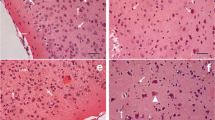Summary
In rats with signs of onset of organic mercury poisoning, marked changes were noted in the granule cells of the cerebellum. In the initial stage of the disease, selective damage to granule cells was characteristic probably due to disturbance in protein synthesis. Mitochondria showed only relatively mild changes even at a considerably later stage, after disappearance of intracytoplasmic organelles from the granule cells.
Two changes were distinguished in the granule cells. One was the streaming out of the intranuclear substance while the other was coagulation of the nucleus. On the 150th day after cessation of administration of organic mercury, pathological change involved not only the cerebellum but also the cerebrum and the brain stem. Another two changes were observed in the granule cells. Changes in the blood brain barrier, vascular satellite cells, glia and synapse were mild as compared with those in the granular cells. No specific correlation was noted between vascular distribution or vascular changes and changes in the granular cells.
Zusammenfassung
In den Fällen von organischer Quecksilbervergiftung, bei denen Symptome festgestellt wurden, ließen sich deutliche Veränderungen an den Körnerzellen des Kleinhirns beobachten. Das Frühstadium der Erkrankung war gekennzeichnet durch einen selektiven Befall der Körnerzellen, der als wahrscheinliche Folge der Störung der Proteinsynthese zu deuten ist. Die Mitochondrien boten verhältnismäßig leichte Veränderungen, sogar im späten Stadium nach Verschwinden intracytoplasmatischer Organellen in den Körnerzellen.
Beim Erkrankungsprozeß der Körnerzellen waren 2 Typen unterscheidbar: Typ I mit Ausströmen intranucleolären Materials und Typ II mit Gerinnung des Zellkerns.
Am 150. Tag nach Ende der Verabreichung erstreckten sich pathologische Veränderungen nicht nur auf das Kleinhirn, sondern auch auf Großhirn und Hirnstamm: ferner wurden 2 Typen von Veränderungen an den Körnerzellen beobachtet.
Die Veränderungen im Bereich der Blut-Hirnschranke, in vasculären Satelliten, Gliazellen und Synapsen waren geringer als jene Körner-Zellen.
Zwischen der Gefäßverteilung bzw. vasculären Veränderungen und Veränderungen in den granulären Zellen wurde keine spezifischen Korrelationen festgestellt.
Similar content being viewed by others
References
Brown, W. J., andN. Yoshida: Organic mercurial encephalopathy. Advanc. Neurol. Sci.9, 34–42 (1965).
Das, H. K., S. K. Chatterjee, andS. C. Roy: Protein synthesis in plant mitochondria. I. Incorporation of amino acid in peptide linkage. J. biol. Chem.236, 1126–1133 (1964).
Hirakawa, K.: Isolation and identification of organic mercury compounds contained in Hibarigaimodoki obtained from Minamata bay. J. Kumamoto med. Soc.36, 746–763 (1962).
Hunter, D., R. R. Bombord, andD. Russell: Poisoning by methyl mercury compounds. Quart. J. Med.33, 193–219 (1940).
—, andD. S. Russell: Focal cerebral and cerebellar atrophy in human subject due to organic mercurial compounds. Neurol. Neurosurg. Psychiat.17, 235–241 (1954).
Inoue, T.: Identification of an organic mercury compound, methyl methylmercuric sulfide. Its synthesis analytical chemical study and the role in the etiology of Minamata's disease. J. Kumamoto med. Soc.36, 877–889 (1962).
Irukayama, K.: Studies on the mercury compounds in the fish and shellfish from Minamata bay as the causative agent of Minamata disease and the formation of the poison (I–VI). Nippon Eiseigaku Z.16, 385 (1961);16, 467 (1962);19, 238, 246 (1964).
Littlefield, J. W., E. B. Keller, J. Gross, andP. C. Zamecnik: Studies on cytoplasmic ribonucleoprotein particles from the liver of the rat. J. biol. Chem.217, 111–121 (1955).
McLean, J. R., C. L. Cohn, I. R. Brandt, andM. V. Simpsom: Incorporation of labeled amino acids into the protein of muscle and liver mitochondria. J. biol. Chem.233, 657–663 (1958).
Palay, S., S. Mcgee-Russell, G. Spencer, Jr., andM. A. Grills: Fixation of neural tissues for electron microscopy by perfusion with solution of osmium tetroxide. J. Cell Biol.12, 385–410 (1962).
Takeuchi, T., andN. Morikawa: Pathological studies on Minamata diease, especially on the cause of this disease. Psychiat. Neurol. Jap.62, 1850 (1960) (in Japanese, with English abstract).
——,H. Matsumoto, andY. Shiraishi: A pathological study of Minamata disease in Japan. Acta neuropath. (Berl.)2, 40–57 (1962).
—,H. Matsumoto, Y. Shiraishi, G. Koya, M. Sasaki, Y. Hirata, K. Fukimoto, T. Miyazaki, andJ. Ogi: An experimental pathological study on the etiology of Minamata's disease, especially the role of methylmercuric sulfide. J. Kumamoto med. Soc.36, 713–735 (1962).
——,H. Deguchi, M. Sonoda, andF. Kai: Experimental formation of cerebellar atrophy. Cerebellar disturbance by alkylmercury poisoning. Kumamoto Igk. Z.40, 1003 (1966).
——,G. Koya, H. Deguchi, M. Sonoda, andF. Kai: A histopathological study of the brain of cats poisoned with methylmercuric compounds. Kumamoto Igk. Z.40, 1016 (1966).
Tokuomi, H., andT. Okajima: Minamata disease. Wld Neurol.2, 536–545 (1961).
Uchida, M., K. Hirakawa, andT. Inoue: Biochemical studies on Minamata disease (III–IV). Kumamoto med. J.14, 171, 181 (1961);15, 149 (1962).
Yoshino, Y., T. Mozai, andK. Nakao: Distribution of mercury in the brain and its subcellular units in experimental organic mercury poisoning. J. Neurochem.13, 397–406 (1966).
———: Biochemical changes in the brain in rats poisoned with an alkyl mercury compound, with special reference to the inhibition of the protein synthesis in brain cortex slices. J. Neurochem.13, 1223–1230 (1966).
Author information
Authors and Affiliations
Rights and permissions
About this article
Cite this article
Miyakawa, T., Deshimaru, M. Electron microscopical study of experimentally induced poisoning due to organic mercury compound. Acta Neuropathol 14, 126–136 (1969). https://doi.org/10.1007/BF00686349
Received:
Issue Date:
DOI: https://doi.org/10.1007/BF00686349




